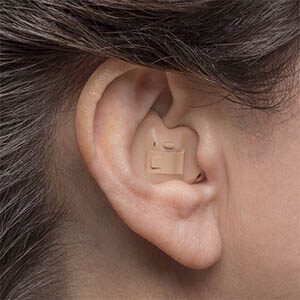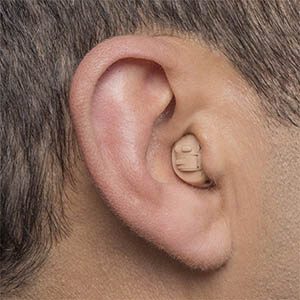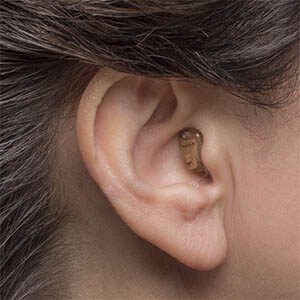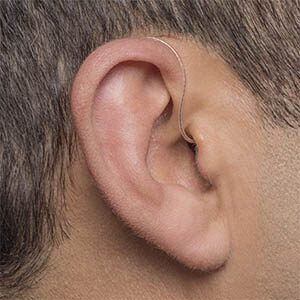Advanced Prescription Hearing Aid Technology
Advanced Prescription Hearing Aid Technology
Advanced Prescription Hearing Aid Technology To Enhance Your Quality Of Life
You probably imagine those bulky, frustrating gadgets your parent or grandparents wore whenever someone mentions prescription hearing aids. However, many of the people we work with tell us that friends, colleagues, and/or loved ones have never noticed that they are wearing a hearing device.
The lighter, smaller, and more discrete nature of modern prescription hearing aids is thanks to the same micro-digital technology that has made cell phones smaller and more powerful than ever. Just like your smartphone, today’s hearing aids have powerful sound processing capabilities in order to provide incredible clarity, block out background noise, and improve the quality of sound you hear.
Features like rechargeable batteries, user-friendly programming and adjustment, and the capacity to connect your smartphone, computer, and television directly to your hearing aids help destroy those outdated stigmas associated with prescription hearing aids.

After several years of feedback from family and friends, I knew I needed help with my hearing. I went to a big box store and tried their recommend solution, but I was not convinced it was the right solution for me. I then contacted south Shore hearing explained my concerns. I was pleased with the staff’s credentials, their attention to my hearing issues and my personal preferences.. I made the decision, in part because of the convenient payment option they offered, and got the hearing aids. My family are very happy with the results!




Setting The Record Straight About Prescription Hearing Aids
Myth: Personal sound amplifiers (PSAs) and hearing aids are the same things.
Fact: Though capable of increasing overall volume, PSAs were created for recreational activities but are incapable of adapting to your environment the way hearing aids do. They are not FDA-approved as comparable replacements for hearing aids and can damage your hearing rather than help it.
Myth: Hearing aids make everything sound too loud.
Fact: Advanced sound processing and noise-reduction technology make it possible for hearing aids to adapt to the various environments you, reducing or eliminating background noise and producing greater sound clarity. Advanced technology hearing aids provide the best solution for addressing each unique type and severity of hearing loss.
Myth: You buy hearing aids online or by mail to save money.
Fact: Each person with a hearing challenge experiences a unique type and severity of hearing loss, which can only be identified through a hearing assessment that follows best practices and is conducted by a hearing care professional. Without a hearing assessment, your specific hearing needs will not be met by an over-the-counter (OTC) hearing device, and you could do additional damage to your hearing as well.
Myth: Hearing aids are bulky and make people feel old.
Fact: Today’s smaller and lighter-weight hearing devices are nearly invisible. However, their ever-increasing sound processing power continues to improve hearing clarity for hearing aid wearers. Today’s technology makes it possible to fit all lifestyles, making your hearing loss more noticeable than your hearing aids.
Myth: Hearing aids are too expensive.
Fact: When you add up the costs of depression and anxiety, strained relationships, dementia, balance disorders, and decreased productivity associated with leaving your hearing loss untreated is costly. In contrast, a well-fitted, well-maintained device, along with hearing care provided by a hearing care professional, is a cost-effective long-term investment in a better quality of life.
Myth: I only need one hearing aid because I hear just fine out of my good ear.
Fact: Your “good ear,” the one you learn to favor for the telephone or during conversations, creates the illusion that “the better ear” is normal when it isn’t. In reality, 90% of people with hearing challenges in one ear need hearing aids for both ears.
Myth: I don’t struggle with hearing in general, just certain sounds.
Fact: The loss of certain sounds, not all sounds, is still hearing loss because the sounds you are missing are critical when it comes to your capacity to communicate, perform daily living tasks, and live an independent lifestyle. Hearing care professionals program hearing aids to amplify the sounds you’re missing, which enhances your overall hearing and boosts your quality of life.
Myth: Tinnitus is an incurable disease.
Fact: Tinnitus is not a disease but a symptom of a neurological problem often caused by exposure to loud noise, ototoxic medications, blood pressure/circulation issues, stress, or a number of other issues. Though there is no cure for tinnitus, various management devices and coping strategies can help reduce the effect tinnitus has on you and your lifestyle.
Choose From A Variety Of Prescription Hearing Aid Styles
You probably imagine those bulky, frustrating gadgets your parent or grandparents wore whenever someone mentions prescription hearing aids.
However, many of the people we work with tell us that friends, colleagues, and/or loved ones have never noticed that they are wearing a hearing device.
South Shore Hearing Centers can make a wide range of advanced technology prescription hearing aids available to you because we work with many different hearing aid manufacturers, like Widex, Phonak, Starkey, Oticon, Unitron, and ReSound.
Your hearing care expert will help guide you through the process of choosing the level of technology you need to meet your unique hearing care needs, as well as the style and features that fit your lifestyle, budget, and personal preferences.
The lighter, smaller, and more discrete nature of modern prescription hearing aids is thanks to the same micro-digital technology that has made cell phones smaller and more powerful than ever. Just like your smartphone, today’s hearing aids have powerful sound processing capabilities in order to provide incredible clarity, block out background noise, and improve the quality of sound you hear.
Features like rechargeable batteries, user-friendly programming and adjustment, and the capacity to connect your smartphone, computer, and television directly to your hearing aids help destroy those outdated stigmas associated with hearing aids.
- In The Ear (ITE)
- Full Shell in the Ear (ITE)
- In the Canal (ITC)
- Completely in Canal (CIC)
- Invisible in Canal (IIC)
- Behind-the-Ear (BTE)
- BTE with Earmold
- Open Fit Mini BTE
- Receiver in the ear (RITE) or Receiver in ear (RIC)
- Over The Counter (OTC)
 ITE hearing aids house the receiver and all of the instrument’s technology in a custom-fit casing that fits the contours of your ear. People who wear glasses or use an oxygen cannula enjoy an advantage from this style over traditional behind-the-ear style hearing aids. ITE styles come in a variety of sizes to meet your needs.
ITE hearing aids house the receiver and all of the instrument’s technology in a custom-fit casing that fits the contours of your ear. People who wear glasses or use an oxygen cannula enjoy an advantage from this style over traditional behind-the-ear style hearing aids. ITE styles come in a variety of sizes to meet your needs.
 Full shell hearing aids sit flush within the entire ear bowl, allowing for the maximum number of additional controls and features, such as directional microphones, larger batteries, and greater processing power. ITE styles can address severe cases of hearing losses due to their capabilities and flexibility.
Full shell hearing aids sit flush within the entire ear bowl, allowing for the maximum number of additional controls and features, such as directional microphones, larger batteries, and greater processing power. ITE styles can address severe cases of hearing losses due to their capabilities and flexibility.
 ITC instruments sit in the lower portion of the outer ear bowl. Smaller than full-shell devices and slightly larger than CIC models, they support a more powerful battery with longer service life, allowing for advanced features like directional microphones and easier adjustment while also providing increased wearing discretion. They provide an adequate solution for individuals with mild to moderate hearing loss.
ITC instruments sit in the lower portion of the outer ear bowl. Smaller than full-shell devices and slightly larger than CIC models, they support a more powerful battery with longer service life, allowing for advanced features like directional microphones and easier adjustment while also providing increased wearing discretion. They provide an adequate solution for individuals with mild to moderate hearing loss.
 Smaller still, CIC instruments fit within the outer portion of the ear canal but not as deep as IIC devices. They offer high cosmetic appeal since they are nearly invisible when worn, but they lack some of the adjustment capabilities and processing power of larger units. They can be used by individuals with mild to moderate hearing loss.
Smaller still, CIC instruments fit within the outer portion of the ear canal but not as deep as IIC devices. They offer high cosmetic appeal since they are nearly invisible when worn, but they lack some of the adjustment capabilities and processing power of larger units. They can be used by individuals with mild to moderate hearing loss.
 IIC instruments are the smallest custom style, designed to sit past the second bend of the ear canal. They are designed to meet the needs of those with mild to moderate hearing loss who want the ultimate level of wearing discretion.
IIC instruments are the smallest custom style, designed to sit past the second bend of the ear canal. They are designed to meet the needs of those with mild to moderate hearing loss who want the ultimate level of wearing discretion.
 The technology of BTE models sits behind or on top of the outer ear. Tubing or wiring routes sounds from the receiver to an ear tip or earmold that is inserted into the ear canal. Like ITE devices, BTE devices come in a variety of styles and technologies. Increased processing power, easier access to make adjustments, and more powerful/rechargeable batteries are among the advantages of BTE hearing aids.
The technology of BTE models sits behind or on top of the outer ear. Tubing or wiring routes sounds from the receiver to an ear tip or earmold that is inserted into the ear canal. Like ITE devices, BTE devices come in a variety of styles and technologies. Increased processing power, easier access to make adjustments, and more powerful/rechargeable batteries are among the advantages of BTE hearing aids.
 The most common type of hearing aid, often referred to as “traditional” hearing aids, are BTEs with earmolds. This type of hearing aid has the power to provide assistance to individuals experiencing all levels of hearing loss, from mild to severe. Their behind-the-ear casing follows the contour of the outer ear and includes a broader range of programming and adjustment features than other types of hearing devices.
The most common type of hearing aid, often referred to as “traditional” hearing aids, are BTEs with earmolds. This type of hearing aid has the power to provide assistance to individuals experiencing all levels of hearing loss, from mild to severe. Their behind-the-ear casing follows the contour of the outer ear and includes a broader range of programming and adjustment features than other types of hearing devices.
 Mini BTEs hide behind the outer ear and feature ultra-thin tubing/wiring to discreetly transmit sound into the ear. The tubing/wiring connects to a soft tip, which sits in the ear canal without plugging it, allowing for a natural, open feeling of airflow while amplified sound enters through the tip. This is known as “open fitting” and is recommended for individuals experiencing mild to moderate high-frequency losses.
Mini BTEs hide behind the outer ear and feature ultra-thin tubing/wiring to discreetly transmit sound into the ear. The tubing/wiring connects to a soft tip, which sits in the ear canal without plugging it, allowing for a natural, open feeling of airflow while amplified sound enters through the tip. This is known as “open fitting” and is recommended for individuals experiencing mild to moderate high-frequency losses.
 RITE or RIC models are similar to mini BTEs but have the speaker of the instrument incorporated into the ear tip instead of in the main body behind the ear. These instruments are designed for discreet wearing by individuals with mild to severe hearing losses.
RITE or RIC models are similar to mini BTEs but have the speaker of the instrument incorporated into the ear tip instead of in the main body behind the ear. These instruments are designed for discreet wearing by individuals with mild to severe hearing losses.
 These pioneering hearing-enhancing earbuds have been specifically engineered with advanced medical-grade technology, to help you focus on what you want to listen to, without just turning up the volume. The innovative design uses 4 dedicated microphones to reduce background noise and improve speech clarity, so whether you’re chatting with your partner in a busy café or catching up with friends over dinner, the sounds that matter will be crystal-clear.
These pioneering hearing-enhancing earbuds have been specifically engineered with advanced medical-grade technology, to help you focus on what you want to listen to, without just turning up the volume. The innovative design uses 4 dedicated microphones to reduce background noise and improve speech clarity, so whether you’re chatting with your partner in a busy café or catching up with friends over dinner, the sounds that matter will be crystal-clear.
Reviews
Hear What Our Patients Have To Say
The Importance Of Scheduling A Hearing Assessment
The only way to know the truth about your hearing loss, its severity, treatment, and preventive measures to stop ongoing damage is with a hearing assessment. Consequently, scheduling a hearing assessment is your first step on the journey to better hearing.
If you or a loved one is not hearing as well as they used to, then it is time to fill out and submit our “Schedule a Hearing Assessment” form and let us help you hear better.
"*" indicates required fields







